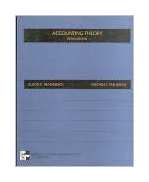|
||
• wydawnictwa polskie
• Zamów informacje o nowościach z wybranego tematu • kontakt
• Cookies na stronie |
ACCOUNTING THEORYHENDRIKSEN E.wydawnictwo: MCGRAW-HILL , rok wydania 2001, wydanie Vcena netto: Accounting Theory This fifth edition, like its predecessors, is designed to provide a frame of reference for junior, senior, and graduate courses in financial accounting and financial accounting theory; seminars on financial accounting standards and issues; and seminars on the theory of income and asset valuation. Those who wish to obtain a good understanding of financial accounting standards or want a general survey of financial accounting theory and those who wish to study for the theory section of the Uniform CPA Examination should also find this book useful. It is assumed that the reader has a knowledge of the basic structure of accounting. Experience has shown, however, that mature students who have not studied accounting can understand the subject matter with concurrent additional formal or independent study of this basic structure. A background in finance or economics can also lead into this book. A general frame of reference has been used to evaluate the many areas of financial accounting theory and practice. The frame of reference includes a number of theories that are not necessarily consistent with each other and that may lead to different conclusions. Evaluations are made at three basic levels:
Emphasis is placed on the inductive-deductive and the capital market approaches in the evaluations, although other approaches are discussed where appropriate. In some cases, the several viewpoints resulting from the different approaches are criticized without attempting to suggest a solution or the best alternative. In other cases, the authors have expressed their own views and presented supporting evidence based on a priori logic and empirical findings where available. In all cases, suggested solutions are tentative and subject to change as new evidence becomes available. The first eight chapters of this edition develop the foundations of accounting theory. They include an introductory chapter, including a section on methodology, two chapters on the development of accounting, a chapter on how generally accepted accounting principles have evolved, a chapter describing the elements of financial reporting, a chapter on capital market theory, another on decision theory, and one on accounting regulation. The next three chapters examine the income statement. They include two chapters on income measurement and one on revenues and expenses. A chapter on reporting for price changes emphasizes their effect on income determination, but also discusses the problems of asset measurement under conditions of changing prices, including the use of current costs. This is followed by eight chapters on the statement of financial position, each growing more specific than the last. Assets are treated first, then liabilities, and finally equity. The final chapter discusses the disclosure of relevant information to investors, creditors, and other interested readers of financial statements. A revolution has occurred in accounting in the years in which this book has appeared. Where once inductive-deductive reasoning was dominant, today empirical studies cast in a pragmatic framework are the rule. This edition has sought to reflect this change by expanding its coverage of recent research, while not neglecting the contributions of earlier researchers in accounting. Among the basic changes in this edition are:
8. The addition of much new end-of-chapter material, including a number of new cases. 904 pages Księgarnia nie działa. Nie odpowiadamy na pytania i nie realizujemy zamówien. Do odwolania !. |


